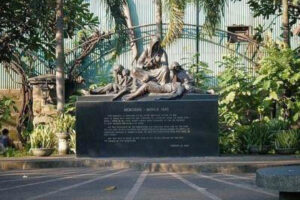Removal of World War II memorials may be imminent

“My bilateral visit to Japan is essential and is part of a larger foreign policy agenda to forge closer political ties, stronger defense and security cooperation as well as lasting economic partnership,” President Ferdinand Marcos, Jr. said in his departure speech last Wednesday.
Closer political ties, security cooperation, and economic partnership to be forged and to endure require a show of trust, respect, understanding, and willingness to compromise by both countries. If there had been conflict between the two countries in the past, fallouts from the conflict should be forgiven and forgotten.
It will be recalled that sometime in December 2021, people learned, to their extreme puzzlement, that the portraits of World War II heroes Jose Abad Santos, Vicente Lim, and Josefa Llanes Escoda in the P1,000 bank note would be replaced by the Philippine Eagle. There is something the three have in common. The three played key roles in the Philippine resistance to the Japanese occupation in 1942 to 1945. All three were executed by the Japanese military.
Jose Abad Santos was an Associate Justice of the Supreme Court when World War II broke out. President Manuel Quezon named him Chief Justice on Dec. 24, 1941 and subsequently designated him Acting President. In April 1942, he and his son were captured by the Japanese. When he refused to cooperate with the Japanese occupation government, he was executed.
Gen. Vicente Lim, the first Filipino to graduate from the US Military Academy in West Point, was in command of the 41st Infantry Division of the Philippine Army in Bataan. After four months of fierce fighting, all Filipino and American forces in Bataan were ordered to surrender on April 9, 1942.
After his release as a prisoner of war, he joined the resistance against the Japanese invaders by funding various guerrilla activities and providing information on Japanese troop movement and military installation. But in June 1944, Lim was captured, brought to Fort Santiago where he was tortured, then to the Chinese Cemetery where he was beheaded.
Josefa Llanes Escoda was a civic leader and social worker. Following the fall of Bataan, she and her husband Antonio mobilized the staff of the National Federation of Women’s Clubs, of which she was the secretary, to make the connections between prisoners of war and their families. They also supplied medicine, food, and messages to both prisoners in Japanese garrisons and internees in internment camps. They were arrested for their activities and subsequently executed.
Some civil society groups suspected the removal of the portraits of the World War II heroes was part of the conditions for Japan’s support of the country’s infrastructure program worth trillions of US dollars.
There is good reason for such suspicion. In April 2018, the statue of the Comfort Woman (a sex slave of the Japanese soldiers in World War II) in Baywalk, Roxas Boulevard, Manila was removed. The statue was a representation of the estimated 1,000 young Filipino women who were either abducted, coerced, or deceived to serve as sexual slaves for hundreds of Japanese soldiers during the Japanese occupation.
The city government of Manila provided the place for the statue. The National Historical Commission of the Philippines (NHCP) installed the marker on the pedestal. My translation of the inscription, which is in Pilipino, is: “This monument is a memorial of the Filipino women who were victims of abuse during the Japanese occupation (1942-1945). A long time passed before they testified and gave a statement about their experience.”
The statue was formally unveiled on Dec. 8, 2017. But days after the installation, officials of the Department of Foreign Affairs (DFA) formally sought through a letter marked “extremely urgent,” an explanation from the City Hall of Manila and the NHCP regarding the statue. The DFA cited the sensitivity of the “comfort women issue” to Japan.
Officials from the Japanese embassy also went to see Manila officials to express their objection to the statue. DFA Secretary Alan Peter Cayetano said the statue would adversely affect Philippines-Japan relations.
On April 27, 2018, personnel of the Department of Public Works and Highways removed the statue, supposedly “to give way to a drainage improvement project along the Baywalk.” Anyway, the sympathizers of comfort women unveiled a new statue that no government agency can touch. It is located in a private property — the courtyard of the Redemptorist Church in Baclaran, Parañaque. The marker says: “The statue stands as a reminder that wars of aggression must always be opposed, and that sexual slavery and violence should never happen again to any woman, anywhere at any time.”
If a statue representing Filipino women forced into sexual slavery by the Japanese Imperial Army was troubling to Japanese, the memorial in Intramuros for the more than 100,000 civilians who perished during the Battle of Manila in February 1945 would be much more upsetting to them because of the sculpture and the inscription. The marker on the monument Memorare-Manila 1945 on Anda Street near General Luna Street, Intramuros, says:
“This monument is erected in memory of the more than 100,000 defenseless civilians who were killed during the Battle for the Liberation of Manila between February 3 and March 3, 1945. They were mainly victims of heinous acts perpetrated by the Japanese Imperial Forces and the casualties of the heavy artillery barrage by the American Forces. The Battle for Manila at the end of World War II was one of the most brutal episodes in the history of Asia and the Pacific. The non-combatant victims of that tragic battle will remain forever in the hearts and minds of the Filipino people.”
Intramuros is a popular tourist destination. The huge size of the monument attracts the curiosity of tourists. Removal or relocation to a private place of the monument at the instance of Japanese officials will certainly draw the ire of the surviving children and close relatives — there are thousands of them — of those killed during the Battle of Manila. I think the most that can be done to please Japanese officials would be the removal of the phrase “They were mainly victims of heinous acts perpetrated by the Japanese Imperial Forces” from the marker.
Much less conspicuous than the monument in Intramuros but just as disturbing to Japanese sensitivity is a marker in a building in the campus of the University of Santo Tomas in Sampaloc, Manila. The inscription says:
“Through these portals passed up to ten thousand Americans and other nationals of the free world who were interned within these walls by the Japanese military, suffering great physical and national humiliation from January 4, 1942, until liberated February 3, 1945, by the American Forces under General Douglas MacArthur.”
The building was used to house civilians numbering more than 3,000, mostly American businessmen and executives of subsidiaries of American companies and their families, Catholic priests and nuns, and Protestant missionaries. Thirty to 50 people were crowded into small classrooms in university buildings.
Little food was provided them by the Japanese Army. Sanitation was poor. Bathrooms and toilets were too few for the thousands of internees. Many died of starvation or of unavailability of medical care. Internees rescued by the American troops in February 1945 were emaciated and near death.
The marker is beyond the prerogatives of Philippine government officials, national or local, as the marker is in a building in a private property and was installed by the American Association of the Philippines.
There are other World War II memorials outside Manila that are as disconcerting to Japanese. They are the Capas National Shrine in the former concentration camp for Allied prisoners in Capas, Tarlac, and a marker in a building in the UP College of Agriculture in Los Baños, Laguna. The building served as an internment camp similar to the one in the University of Santo Tomas campus. But because they are in remote places unlikely to be visited by Japanese tourists, they are probably of no concern to officials of the Japanese Embassy.
But there is something Mr. Bongbong Marcos can do well within his prerogatives as president and as son of Ferdinand Marcos that would please both Filipinos and Japanese — to cease calling the proposed Sovereign Wealth Fund the Maharlika Investment Fund. “Maharlika” is the name of the supposed guerrilla unit of Ferdinand Marcos during the Japanese occupation. There are no records that affirm the existence of such a unit. It was merely a fiction of Bongbong Marcos’ father.
To please the Japanese immensely, he can also order the revision of the book For Every Tear a Victory. The chapter on his father’s war exploits should be expunged from the book. Ferdinand Marcos’ war stories are pure tall tales!
Oscar P. Lagman, Jr. is a retired corporate executive, business consultant, and management professor. He has been a politicized citizen since his college days in the late 1950s.




